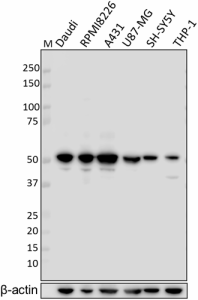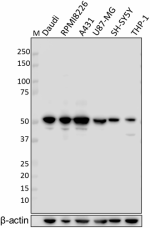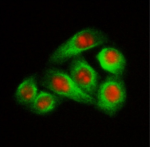- Clone
- 1H6B44 (See other available formats)
- Regulatory Status
- RUO
- Other Names
- Bifunctional lysine-specific demethylase and histidyl-hydroxylase MINA, 60S ribosomal protein L27a histidine hydroxylase, Histone lysine demethylase MINA, MYC-induced nuclear antigen, Nucleolar protein 52 (NO52), Ribosomal oxygenase MINA (ROX), MDIG
- Isotype
- Rat IgG2a, κ
- Ave. Rating
- Submit a Review
- Product Citations
- publications

-

Total cell lysates (15 µg total protein) from Daudi, RPMI8226, A431, U87-MG, SH-SY5Y, and THP-1 (reduced expression control) cells were resolved by 4-12% Bis-Tris gel electrophoresis, transferred to a nitrocellulose membrane, and probed with 1.0 µg/mL (1:500 dilution) of Purified anti-MINA Antibody, clone 1H6B44, overnight at 4°C. Proteins were visualized by chemiluminescence detection using HRP goat anti-rat IgG Antibody (Cat. No. 405405) at a 1:3000 dilution. Direct-Blot™ HRP anti-β-actin Antibody (Cat. No. 643807) was used as a loading control at a 1:5000 dilution (lower). Lane M: Molecular Weight marker. Predicted expression data was obtained from Human Protein Atlas. -

HeLa cells were fixed with 4% paraformaldehyde (PFA) for 15 minutes, permeabilized with 0.5% Triton X-100 for three minutes, and blocked with 1% BSA for 60 minutes. Then the cells were intracellularly stained with 2.5 µg/ml purified anti-MINA (clone 1H6B44) antibody for one hour, followed by staining with Alexa Fluor® 594 conjugated goat anti-rat IgG antibody (red) and Alexa Fluor® 488 anti-Tubulin-α antibody (green) for one hour at room temperature. The image was captured with a 40X objective.
| Cat # | Size | Price | Quantity Check Availability | Save | ||
|---|---|---|---|---|---|---|
| 683302 | 100 µg | 212€ | ||||
MINA, also known as Mineral dust-induced gene (MDIG), is a member of the JmjC family of proteins and can act as a histone lysine demethylase and a ribosomal histidine hydroxylase. MINA is implicated in the demethylation of K9 trimethylated histone H3 (H3K9me3), regulating cell proliferation and survival. MINA has been suggested to be a novel oncogene associated with a variety of cancers. Elevated expression of MINA in human tumors has been linked to malignancy and poor prognosis. MINA has been identified as a transcriptional co-repressor of IL-4 gene and participates in the regulation of Th2 differentiation and Th2 bias. MINA appears to be a regulator of the Treg/Th17 balance by promoting differentiation of Th-17 cells and inhibiting FOXP3 expression.
Product DetailsProduct Details
- Verified Reactivity
- Human
- Antibody Type
- Monoclonal
- Host Species
- Rat
- Immunogen
- Partial recombinant protein (300-465 aa) expressed in E. coli.
- Formulation
- Phosphate-buffered solution, pH 7.2, containing 0.09% sodium azide.
- Preparation
- The antibody was purified by affinity chromatography.
- Concentration
- 0.5 mg/ml
- Storage & Handling
- The antibody solution should be stored undiluted between 2°C and 8°C.
- Application
-
WB - Quality tested
ICC - Verified - Recommended Usage
-
Each lot of this antibody is quality control tested by Western blotting. For Western blotting, the suggested use of this reagent is 0.5 - 2.5 µg/ml. For immunocytochemistry, a concentration range of 1.0 - 5.0 μg/ml is recommended. It is recommended that the reagent be titrated for optimal performance for each application.
- RRID
-
AB_2566795 (BioLegend Cat. No. 683302)
Antigen Details
- Structure
- 465 amino acids with a predicted molecular weight of 52.8 kD. Contains a JmjC domain responsible for lysine demethylation of histones.
- Distribution
-
Nucleus and nucleolus.
- Function
- MINA is an oxygenase exerting histone lysine demethylase and ribosomal histidine hydroxylase activities. It is involved in cell proliferation, survival, and T cell differentiation.
- Interaction
- MINA interacts with Srp72, NOP56, RPL10, EIF3E, HNRNPU, RNPS1, RPL35, and RRBP1.
- Biology Area
- Cell Biology, Neuroscience, Neuroscience Cell Markers, Transcription Factors
- Molecular Family
- Nuclear Markers
- Antigen References
-
1. Thakur C, et al. 2015. Genes Cancer 6:288.
2. Pillai MR, et al. 2014. Curr. Opin. Immunol. 31:38.
3. Lian S, et al. 2013. PLoS One 8:e80638.
4. Hemmers S, et al. 2009. Nat. Immunol. 10:806.
5. Lu Y, et al. 2009. Cell Cycle. 8:2101.
6. Tsuneoka M, et al. 2004. Clin. Cancer Res. 10:7347. - Gene ID
- 84864 View all products for this Gene ID
- UniProt
- View information about MINA on UniProt.org
Related Pages & Pathways
Pages
Other Formats
View All MINA Reagents Request Custom Conjugation| Description | Clone | Applications |
|---|---|---|
| Purified anti-MINA | 1H6B44 | WB,ICC |
Compare Data Across All Formats
This data display is provided for general comparisons between formats.
Your actual data may vary due to variations in samples, target cells, instruments and their settings, staining conditions, and other factors.
If you need assistance with selecting the best format contact our expert technical support team.

 Login / Register
Login / Register 









Follow Us